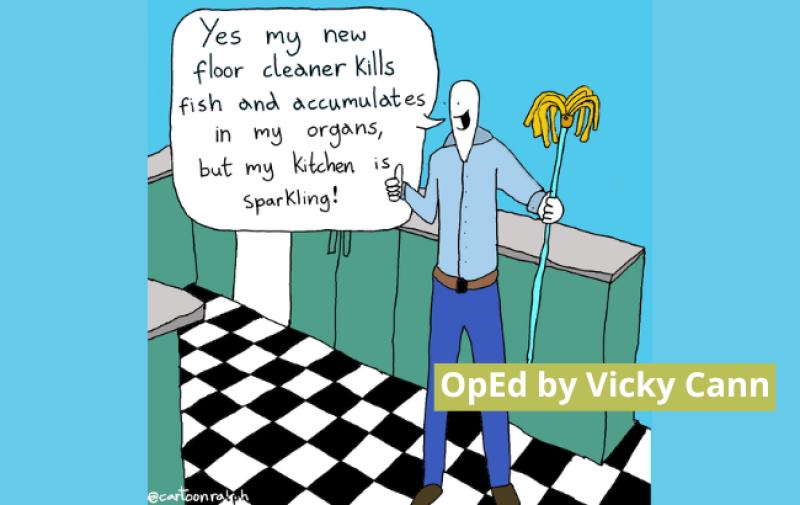Stay always informed
Interested in our articles? Get the latest information and analysis straight to your email. Sign up for our newsletter.

The European Commission is expected to shortly publish its thinking on 'essential use', an important component of the Green Deal's strategy on chemicals. This communication will help determine whether industry can carry on contaminating consumer products (such as childcare articles and textiles) with hazardous substances, or whether such chemicals should only be used when deemed essential and when no safe alternatives exist.
This article was written by Vicky Cann (CEO) and originally appeared in EU Observer.
The commission's ambitious strategy to tackle hazardous chemicals was published in 2020. Ever since industry has lobbied to undermine and dilute its promises — and lobbyists can point to some clear wins, with the recent postponement of the planned revision of REACH, the EU's key chemicals regulation, and the non-appearance of the draft law to ban the export of chemicals and pesticides already banned in the EU.
Corporate Europe Observatory's new research on corporate lobbying to influence the commission's upcoming essential use communication reveals another chapter in this industry operation. Our report analyses over 100 industry lobby documents on this and related topics and exposes several misleading narratives deployed to defend the use of hazardous chemicals in everyday consumer products.
'Essential use' is a concept originating in the Montreal Protocol which says that hazardous substances in consumer products must be banned, except in very limited cases when their use is essential to society and no acceptable alternatives exist.
Perhaps the central argument from industry voices aiming to oppose and weaken the 'essential use' concept has been that it should be balanced by considerations of so-called 'safe use'. This would enable existing hazardous substances to continue to be used in everyday consumer goods, so long as they can be shown to be 'safe'.
Industry's commitment to this argument has led it to create a bespoke lobby group specifically to fight for 'safe use'. The Alliance for Sustainable Management of Chemical Risk (ASMoR) is absent from the EU lobby register, administered by a lobby firm, and supported by various industry players including the American Chamber of Commerce to the EU and the Nickel Institute. It has held several meetings with commission officials.
But industry's 'safe use' approach is pretty much the chemical regulation system we have today — a system which is clearly not working.
Today's system has not prevented the presence of hazardous chemicals in babies' pacifiers or other childcare articles, 'forever chemicals' in dental floss, or known carcinogens in lipstick lids. Balancing 'essential use' with 'safe use' would just be a licence to carry on contaminating.
Meanwhile fragrance, cosmetics, and other 'downstream' industry users of chemicals, have argued that their products are essential, and thereby demanding an 'essential use' definition which would exclude them from being restricted.
But we should not be brain-washed about the essentiality of certain products and the substances contained within them. Surely no products that we ingest, play with, wash our clothes in, or squirt on our skin should contain hazardous substances, by default, unless
the substance is shown to provide a specific essential value to society. And we urgently need a clear regulatory signal that industry must substitute with safer alternatives.
If 'essential use' considerations are to be introduced, according to industry they should be relegated to a regulatory sideshow, "not the main driver for regulatory decisions". Industry is adamant that essential use should not be used as a way to streamline chemicals regulation, as the commission originally envisaged.
This is deeply ironic. Industry usually bombards decision-makers with complaints about so called bureaucratic red tape. But in the case of regulating hazardous chemicals, industry argues for a significantly more laborious, case-by-case process. Today, it can take 10 years or more to restrict a chemical substance; meanwhile the product remains on the market, generating corporate revenue.
But perhaps the award for the most brazen lobbying on essential use must go to ExxonMobil. The fossil-fuel giant, for decades associated with misleading claims about the climate crisis, reportedly told the commission in a lobby meeting that: "'Essential use' should be left to the market ‒ otherwise we will see many unintended consequences."
This rhetoric flies in the face of the irrefutable evidence of the toxic pollution crisis affecting people and the environment worldwide. And if the world had left dealing with ozone depleting substances to industry and the markets instead of regulating it through the Montreal Protocol would we really have seen the major progress in ozone layer recovery?
Industry has had decades to make better decisions about what substances they produce and include in the products they sell to us. But too often those decisions have prioritised profits over people and the planet.
We urgently need a robust approach to essential use from the commission. Regulators need better tools to speed-up the removal of hazardous chemicals from basic consumer goods. And industry must apply the essential use concept itself to make better decisions about the chemicals it puts in the products that we buy.
The toxics industry will always demand a low-ambition regulatory environment and its hefty financial lobby firepower and political reach will continue to undermine public interest decision-making. To speed up action on the pollution crisis, it's time to think seriously about a lobby firewall to protect decision-makers from the influence of the toxics industry.